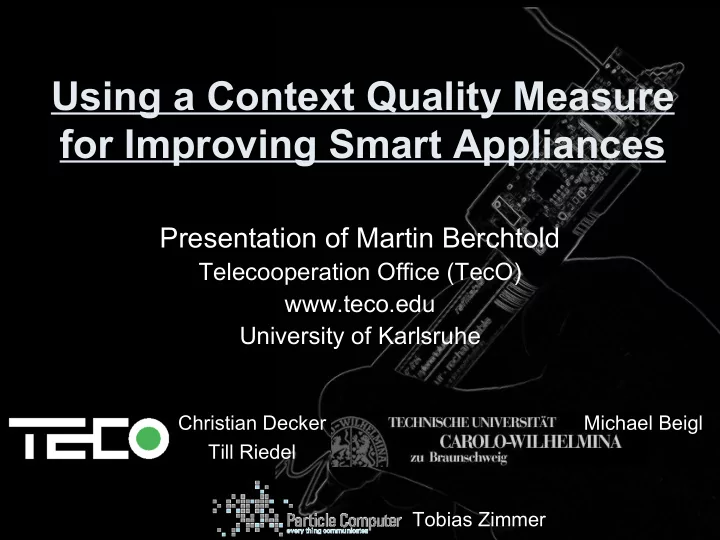

Using a Context Quality Measure for Improving Smart Appliances Presentation of Martin Berchtold Telecooperation Office (TecO) www.teco.edu University of Karlsruhe Christian Decker Michael Beigl Till Riedel Tobias Zimmer
Problem of Context Recognition • Context recognition is not reliable context classification is faulty error lies in used sensors and/or algorithm dependability on faulty systems improvement only to a Abstraction of Context Space certain degree for three Fuzzy Context States 2
Reasoning in Large Scale Ubiquitous Environments • Reasoning is depending on faulty knowledge Reasoning increases error exponentially Error is known only in absolute manner Single data error is mostly not known at runtime • Combination of reliable with unreliable data should be avoided Possible errors should not be included in further reasoning Filtering out faulty data can save communication and calculation resources 3
Existing Systems for Context Recognition • Existing systems for recognizing context want to be reused Obtaining a Context Quality Measure (CQM) should not interfere with existing algorithms User of Quality Analyzing System should need no knowledge of existing recognition system Each piece of context data should be equipped with a CQM Our system for quality analyzing can meet these demands and provides a CQM to filter out faulty data! 4
Fuzzy Inference System (FIS) Non-Linear Error Approximation • Adaptation on system error Systems mostly non-linear System error is non-linear • Fuzzy Inference Systems (FIS) FIS is universal approximation function Infinite set of rules infinite precise approximation [1] • TSK-FIS [2] can deal with non-complete data Lack of data for one state yields to zero mapping of the data zero mapping concludes highest error in our model [1] L X Wang. Adaptive Fuzzy Systems and Control . Prentice-Hall, Englewood Cliffs, 1998. 5 [2] T Tagaki and M Sugeno. Fuzzy identification of systems and its application to modelling and control . IEEE Trans. Syst. Man and Cybernetics, 1985, vol SMC-15, no. 1, pp 116-132 , 1985.
Quality Analysis Context Quality Measure (CQM) • Context classification is considered as a ‘Black-Box’ • Quality analysis input = input of context classification + classification output quality analysis does not interfere with existing contextual algorithms • Knowledge of classification error is stored in FIS due to automated construction and training 6 CQM is representing the error due to elements of the interval [0,1]
Automated Construction and Training of Qualitative FIS • Designated output: 1 right classification 0 false classification • Clustering determines rules [1] • Linear regression fits output functions onto designated output • ANFIS [2] enables training • Hybrid training for fine grain tuning backward-pass: gradient descent Back-Propagation forward-pass: linear regression on bases of Back-Propagation changes [1] Stephen Chiu. Method and software for extracting fuzzy classification rules by subtractive clustering . IEEE Control Systems Magazine, 1996, vol. pp. 461-465 , 1996. 7 [2] Jyh-Shing Roger Jang. ANFIS : Adaptive-network-based fuzzy inference system. IEEE Transactions on Systems, Man and Cybernetics, 1993, vol. 23 pp. 665-685 , 1993.
The AwarePen with CQM • Input: ADXL-sensors x-, y- and z- acceleration • Cueing: s tandard deviation sliding window over 24 values • Mapping: Fuzzy Inference Systems (FIS) 1. FIS: mapping cue values onto context classification of result instead of FIS any other projection could be used 2. FIS: holds knowledge about error of 1. FIS normalization of result • Output: tuple of context identifier and CQM Identifier of current contextual state ‘lying’, ‘writing’ and ‘playing’ 8 CQM is element of interval [0,1]
Using CQM to Filter Contexts Context Quality Measure (CQM) Probabilistic Analysis of CQM • • Right Classified Contexts Density of Right Classified Yellow with mean (dashed line) Yellow curve • • False Classified Contexts Density of Wrong Classified Turquoise with mean (dashed line) Turquoise curve • Possible Filter Threshold 9 Purple line
Argument for Separate CQM-System • CQM for consecutive states ‘lying’, ‘writing’ and ‘playing’ Purple line • Normalized distance of contextual FIS output to class-centre Yellow line QCM contains less noise Reliability of classification is state dependent High correlation proofs 10 comparability
Conclusion and Future Work • Introduction of a system that can provide a Context Quality Measure (CQM) – Quality analyzing system is independent of contextual algorithm – Quality analyzing system can be used for error representation of any contextual algorithm – Filtering contextual knowledge upon CQM is possible with high odds • Future Work – Suitability of quality analysis for other contextual algorithms and systems other than context recognition – Combination of quality analysis with context recognition and preservation of state dependability – Reasoning with CQM according to reasoning with contextual knowledge 11
Recommend
More recommend